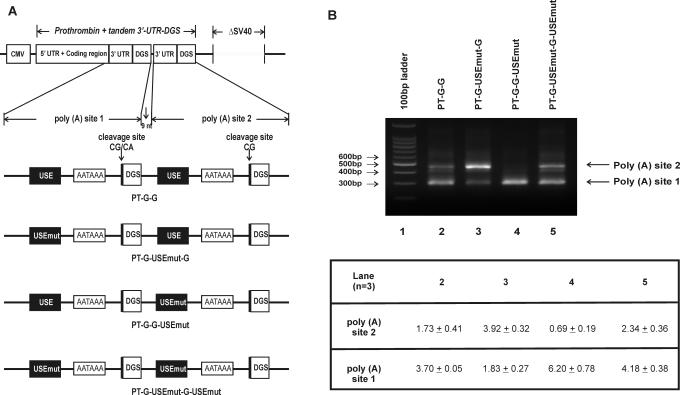Figure 5.
The USE is functional in the presence of tandem prothrombin poly (A) signals. (A) Schematic representation of constructs expressing the full-length wild-type (G allele) prothrombin mRNA with tandem arrangement of the 3′-UTR and DGS indicated as poly (A) site 1 and poly (A) site 2. All constructs contain a 9 nt space between the tandem repeats. Cleavage and polyadenylation elements involved in prothrombin 3′-end formation are indicated: USE, upstream sequence element; DGS, 50 bp downstream genomic sequences; AAUAAA, polyadenylation signal; CG, wild-type cleavage site. The SV40 polyadenylation sequence (ΔSV40) has been removed from all constructs: PT-G-G, prothrombin cDNA with tandem poly (A) sites (poly A sites 1 and 2); PT-G-USEmut-G, contains mutation of USE within poly (A) site 1; PT-G-G-USEmut, contains mutation of USE within poly (A) site 2; PT-G-USEmut-G-USEmut-DGS, contains mutation of the USE within poly A sites 1 and 2. (B) 3′RACE results of RNA from cells transfected with the tandem prothrombin polyadenylation sequence (3′-UTR + DGS). Lane 1, 100 bp DNA ladder; lane 2, PT-G-G; lane 3, PT-G-USEmut-G; lane 4, PT-G-G-USEmut and lane 5, PT-G-USEmut-G-USEmut. The table below represents the quantitation (Image Quant) of the bands generated by prothrombin mRNA expression using poly (A) site 1 (5′) and 2 (3′) ± standard error of the mean (n = 3). The quantitation was corrected for fragment size.

